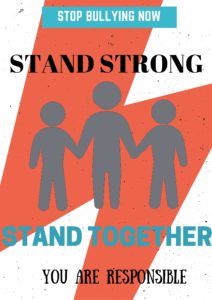Relational Bullying
Posted by Brandon Bader at Friday, May 22, 2015 2:32:41 PM CDT
Relational Bullying or Relational Aggression is the act in which harm is caused by damaging someone’s relationships or social status. Not unlike malice, this form of bullying often takes place in a school setting and is probably the most harmful because it not only involves others, but it involves others seeing that person get publicly humiliated. Often the victims are not in a group of their own and the isolation makes them a target to others because they come across as diferent. Often triggers for this are sexuality, gender, socioeconomic status (SES), or can be as simple as the way that person dresses.
Power is in numbers, something that is equally as common with a pack of animals, there is often a pack leader who instigates the bullying and a number of people who coincide with it. Some who just follow blindly, some who agree with it and some who disagree with what is going on but follows anyway. Within the group the same form of bullying takes place because of fear of being the next potential target if they choose not to follow suit.
In large part there are differences but only between the two genders in how the bullying takes place. Males tend to use more physical pranks in an act of demeaning. The example I used was from the video Bully, Tyler Long was victimized by his peers by being stuffed in lockers and by having his clothes stolen when he would shower forcing him to have to walk around naked. The taunting go to the point where he eventually killed himself. These acts differ from girls where the study of Relational Bullying has been the focus because girls attacks towards others tend to be more psychological and fit the description of ruining someone’s social standing.
The example for girls that was used was the Fab Five Cheerleader Scandal in Texas. A Lifetime movie was made about it and it involved a group of cheerleaders that essentially “Ran” their school without any reprucussions from administration. It was actually clssified as them terrorizing the school with their antics that ranged from skipping class to spreading rumors to even terrorizing their own coaches and teammates. An independent investigator was ultimately called in and faulted the school for allowing it all to happen and at the forefront of it was the mother of the head cheerleader who was also the school’s principal.
Bullying exists in both genders and while different it could also be argued that socially it is necessary. It teaches valuable lessons for those who are on both sides. As I said above, there are components within the group that facilitate the bullying. The ones that follow blindly, the ones tha are fully on board and those who know it isn’t right. For the latter they tend to be the ones better off because at some point they usualy say enough is enough and detatch themselves from that group. It could also be said that it is necessary for those being bullied. Adversity is something that can break us or make us an even better person. As many sad stories as there are there are just as many stories of those who overcome a bully. I’ll attach a video below but a boy was being bullied and retaliated against it, the video went viral and it also showed that a strong enough person will say enough is enough. Not saying that violence is the answer, but violence isn’t not the answer.


I like that you brought another example outside of the class exercises to the conversation. Angela Giannetto
Torina Gedler: This entry was informed and insightful, shedding light on the subject of bullying by comparing children to a pack of animals; dehumanizing them actually lends to better understanding in this case, of the violence and of the “herd” mentalities kids can acquire. I wish it would’ve delved more into the aspect of violence being neither the correct nor the incorrect answer, as it compels me but, at the same time, i am not sure I understand.
Reed Timmer: I agree with how there are many types of people usually involved in a bullying situation, however every situation is different and there may not be on of those groups involved. I do not agree that bullying is necessary for either side. While it may seem to have positive affects like the post stated (getting a kid through adversity etc.) it is not necessary for anyone to be bullied throughout their lifetime. There are many other situations that can teach kids those same lessons without doing all of the harm that bullying causes.
Ally Calvert: I really like how you showed us the stance from the administrator’s side; it shows what they did in these situations. I would like to know what relational bullying really is and how this relates more to the overall picture. I also agree with out on saying that we need to make it known to more students the outcomes of bullying and how to stop it. Good post.
Zachary Berman: I agree that there is a pack mentality that comes with bullying. Members of the pack seek to gain approval from each other by picking on weaker opponents.
Pamela Mulhern: I agree that boys use much more obvious and physical approaches to bullying, whereas
girls tend to be a bit more sneaky and underhanded about it, they target mostly the victim’s psyche. I’ve also come to find that girl’s tend to bully more in groups than boys do, I wonder if you find this to be true as well? My experiences in middle and elementary
schools was that girls were much more vocal with their aggression, whereas boys were definitely more physical about it.
I feel that the idea of the bullying being necessary for the victims really depends on
the level of bullying that occurs with them,and the number of occasions it occurs, I feel that the stuff I went through in middle school helped me to learn to stand up for myself, but the bullying I went through was only a few once off incidences. I can’t
imagine having to deal with it on the constant, and I feel that at some point some people would just shut down from all the pain they’re dealing with.
Marial Williams: You discuss the Lifetime movie, “Ran.” What are the specific relational bullying examples within that movie? Is there something that makes relational bullying different from other types of bullying in a way that we should try to combat it differently? Also, I think that saying violence is the answer in any form is ridiculous. The kids that tend to get bullied the most tend to be the ones who can not defend themselves. Bullying the bully makes you the bully.
Tasha Alexander: I wasn’t really sure what this was so I am glad that they explained what it was and talked in great depth about it. I agree with what they say about girls and what goes on I guess I just never noticed it, I played four different sports in high school and there were many times when relational bullying was happening but I wasn’t around just got told about it and nothing was ever done. They did a nice job at explaining what all goes on and how it all happens.
Susan Smith: I like the statement you included about adversity. I feel that we saw this in the young child who talked about how he used to be a bully in 2nd and 3rd grade but then he rethought it and felt bad about hurting people and changed when her reached 4th grade. In this situation he was the aggressor however adversity is two sided and he was able to learn from it still and changed for the better.
Emily Tyler: I think this posts makes a really good point about the fact that there is not a divide between those who are abled and those who are disabled, but simply that we are all “differenty abled.” This is the kind of diversity-inclusive information that I think we need and that I think a social justice approach to bullying is advocating for; recognizing that we are all different in different ways and that those differences should’t be bullied but just accepted as another aspect of who we are.
Good post and comments. You do a good job of defining relational bullying, and of linking it to what we typically think of as “girl” behavior. What about the relational aspects of masculine bullying? What does Pascoe bring to light on this front? How might her research advance your approach? What does she mean by a systemic approach to bullying?
In regards to your argument about the necessity of bullying or the benefits of it, think critically about the implications of that. Take your argument to its logical conclusion. What are we as a society saying about ourselves and our future if we encourage or just turn attention away from this kind of behavior? How do you apply this to a kid with a developmental or physical disability? My guess is that they have lived more “adversity” than most kids ever will. How does your argument function in regards to other groups that are disproportionately targeted? Your argument focuses on the level of the individuals and the benefits or damages of bullying behavior on them, but how might this look different if you think about it systemically? How are your ideas grounded in social narratives about masculinity, strength, and power?